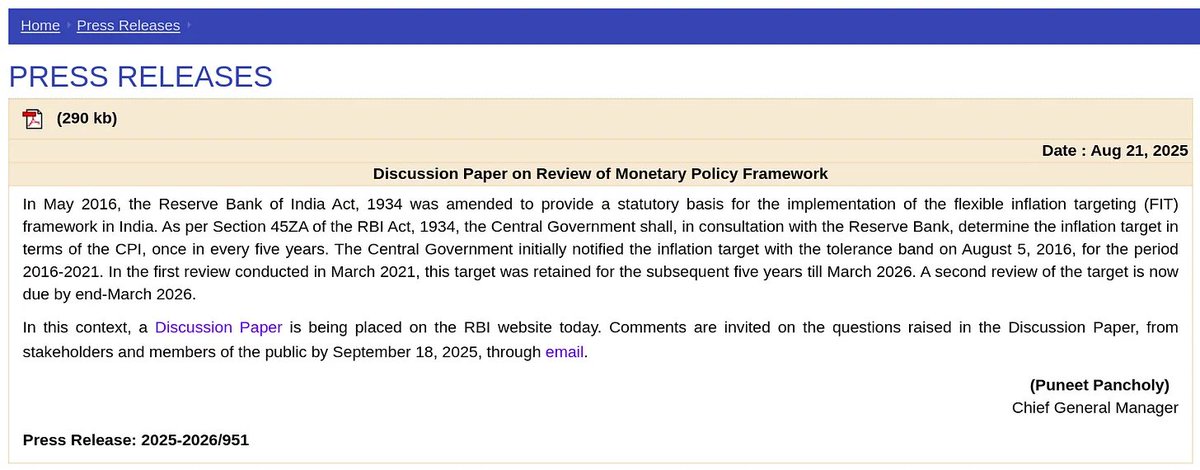The Reserve Bank of India makes decisions that impact 140+ crore people in almost every aspect of their financial lives. So how do we know if the RBI is doing a good job? Turns out, the RBI has something resembling a report card.🧵👇
Back in 2016, Parliament amended the RBI Act to give it a crystal clear mandate, keep prices stable while supporting growth. This was to be measured by how well it stuck to a target, keeping consumer price inflation at 4%, with a tolerance band of 2%.
This target is reviewed every five years. It happened once in March 2021, where it was kept steady at 4% ± 2%. But now, it's review time again. The RBI just released a Discussion Paper ahead of the March 2026 deadline.
In the paper, the central bank asks fundamental questions on whether this is, after all, the right target to set. The RBI is opening up a debate on how exactly it should be judged in the years ahead. 

At its heart, RBI's primary job is managing the amount of money in our economy. It literally prints the notes in your wallet. But it also makes more arcane decisions, like what is the cost of money for a bank, or how much money it must park aside before giving loans.
In doing so, the RBI controls the amount of money moving around the economy. Economists call this monetary policy, and it touches almost everything we care about. If the RBI makes it easier for more money to enter the economy, people spend more.
Sometimes, people start spending too much, and prices climb. When prices are higher, workers demand higher wages. That pushes firms to raise prices again, getting into a loop. Tightening money supply, meanwhile, slows this down.
Cheaper money lowers EMIs and borrowing costs. Businesses borrow that money to invest more in the economy, often leading to more jobs too. Expensive money flips the script, businesses pull back and focus on survival.
The RBI's actions change the price of the rupee on international markets by controlling its supply, and by making trades directly. When the Rupee falls in value, imports turn costlier, resulting in higher prices. Higher rates do the reverse.
This is naturally an important job. It's also very complicated, the effects of which are impossible to measure accurately. So your best bet is to find a good set of proxies that the RBI can go after. That's why we rely on a simple yardstick.
Why is inflation the chosen yardstick? Well, inflation is the most direct thing the RBI can control. Its tools allow it to influence how much money is flowing through the system. The most immediate effect of that is on prices. This makes it a good proxy.
The RBI's aim is to keep prices broadly stable, while rising just enough that people have to put their money to work. Those are the conditions where businesses invest and jobs grow, while households aren't constantly worried about tomorrow's bills.
This isn't unique to India, 48 countries use this framework. And since we adopted it in 2016, it has worked reasonably well in bringing inflation down and keeping prices stable, even through shocks like the pandemic. 

But here's a big question. When we say inflation, should we talk about headline inflation, the entire basket of goods and services an average household consumes? Or should we look at core inflation, which excludes food and fuel, often outside the RBI's control? 

Food and fuel are extremely noisy. Their prices swing with the monsoon, global oil markets, logistics, and trade decisions. Money supply is just a single, distant factor in what they cost. If you judge the RBI on a number dominated by weather and geopolitics, do you risk chasing shadows?
For the average Indian, food and fuel is inflation. They dominate household budgets. The latest Household Consumption Survey shows that 90% of the poorest rural households, and half of the poorest urban ones, spend more than half their monthly outlay on food and energy.
If you drop food and target core inflation, that could break the link between what the RBI tries to do, and the lives of ordinary people. A target that leaves out what actually empties wallets will look tone-deaf, and that could break people's trust in the RBI. 

Most advanced economies aim for about 2% inflation. That's their sweet spot, low enough to lock in price stability, but high enough to avoid the zero-interest-rate trap. Emerging markets live with higher targets, typically 3–6%, and often with a band.
Imagine India cuts its target to 3%. The RBI's research shows that it simply isn't practical. Even if you strip out temporary shocks, India's trend inflation still hovers around 4%. There's also the Balassa-Samuelson effect at play here. 

When a country like India becomes more productive in industries that trade globally, like IT services, wages in those sectors rise. But that drives up wages and prices in other sectors too. An IT worker buys the same things barbers, teachers or delivery workers do.
Empirical studies suggest this effect contributes roughly 2 extra percentage points to India's inflation compared with rich countries. Which means India's natural inflation rate ends up closer to 4%. If the economy's natural drift is around 4% and you set a lower target, you'll simply miss it.
A good report card has to do two things, grade what really matters, and grade only what can actually be delivered. That's exactly what's at stake here, in the choice of inflation measure, the target number, and the width of the band. The RBI's paper invites answers on all three.
We cover this and one more interesting story in today's edition of The Daily Brief. Watch on YouTube, read on Substack, or listen on Spotify, Apple Podcasts, or wherever you get your podcasts.
All links here:thedailybrief.zerodha.com/p/how-does-one…
All links here:thedailybrief.zerodha.com/p/how-does-one…
• • •
Missing some Tweet in this thread? You can try to
force a refresh






